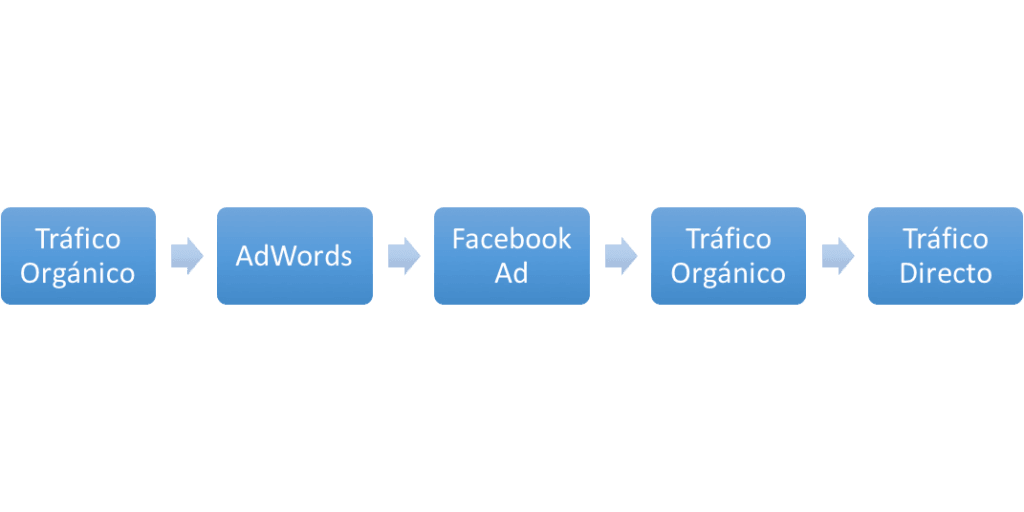Modelos de Atribución: Google Ads, Analytics y Facebook
¡Lo prometido es deuda! En el último post hablábamos de los modelos de atribución que podemos encontrar dentro de la plataforma de Google Ads, y prometíamos analizar las diferencias entre los modelos de atribución de 3 plataformas muy utilizadas en campañas de publicidad y medición de resultados: Google Ads, Facebook y Analytics.
Recordamos brevemente que el modelo de atribución es el esquema que sigue una determinada plataforma para asignar el valor de la conversión a un canal u otro, cuando intervienen varios en la ruta hacia la conversión.
¿Qué Modelos de Atribución utiliza cada plataforma?
Utilizaremos un ejemplo práctico para entenderlo ➡ Marcos quiere comprarse un ordenador nuevo y en su ciclo de compra ha pasado por las siguientes etapas:
- Marcos busca información en Google, y hace clic en un resultado orgánico: un comparador en el que descubre el ordenador que más le gusta: HP57 Pro.
- Marcos busca HP57 Pro de nuevo en Google para comparar precios, y hace clic en uno de los anuncios con un precio interesante. Pero las condiciones de compra de la tienda online a la que ha llegado no le gustan, así que Marcos decide esperar.
- Navegando en su Facebook encuentra un anuncio de «La Tienda Guay» con condiciones muy interesantes y hace click en él. Pero Marcos está fuera de casa y no quiere comprar desde el móvil.
- Por la noche, Marcos busca «La Tienda Guay» en Google para comprar su ordenador y ve una promoción especial que empieza en 24h.
- Al día siguiente Marcos recuerda la dirección de la web, y teclea directamente www.latiendaguay.com en el Omnibox. Se compra el ordenador.
Gráficamente, ésta es la ruta hacia la conversión que Marcos ha seguido:
¿A qué canal podemos asignar la conversión? Veamos cómo lo harán las diferentes plataformas:
-
Modelo de atribución en Google Ads:
Google Ads utiliza un modelo de atribución de último clic de Google Ads. Esto quiere decir que si en la ruta hacia la conversión se produjo una interacción con un anuncios de Google Ads, la plataforma se asignará una conversión, independientemente de que el usuario se haya «cruzado» con más canales a lo largo de esa ruta.
Es decir Google Ads nos dirá que es el autor de la conversión de Marcos.
-
Modelo de atribución de Facebook:
El modelo de Facebook es equivalente al de Google Ads. Si en la ruta hacia la conversión hubo interacción con un anuncio de Facebook, Facebook se asignará una conversión, sin tener en cuenta el resto de canales que han participado para la consecución de ese objetivo.
Por tanto, Facebook nos dirá que es el autor de la conversión de Marcos.
-
Modelo de atribución de Analytics:
Google Analytics utiliza por defecto un modelo de atribución de último clic indirecto. Asigna la conversión al canal en el que se produjo el último clic, salvo que éste sea tráfico directo. En ese caso, lo ignora, asignando la conversión al canal anterior.
Así, Google Analytics nos dirá que el Tráfico Orgánico es el autor de la conversión.
En resumen, cuando la agencia de «La Tienda Guay» 😆 reporte al cliente le dirá que hay una conversión de Google Ads, una de Facebook y una de Tráfico Orgánico = 3 conversiones en total. Pero la realidad es que «La Tienda Guay» sólo habrá registrado una venta dentro de su sistema. Esta problemática adquiere una dimensión más grande a medida que aumentan los canales implicados y podemos encontrarnos con una diferencia muy grande de conversiones atendiendo a los resultados de cada una de las plataformas.
¿Qué solución existe para tener datos más realistas?
La solución pasa por elegir el modelo de atribución más adecuado a nuestro negocio, y analizar siempre los resultados en base a ese modelo. Google Analytics nos permite diferenciar datos de nuestras conversiones de acuerdo con los siguientes modelos de atribución:
-
Modelo Última interacción
La conversión se asigna al canal con el que se dio la última interacción antes de la conversión. Es el modelo adecuado si se considera que es el último canal el que aporta todo el valor para que el usuario convierta.
-
Modelo Último clic indirecto
La conversión se asigna al canal en el que se produjo el último clic antes de la conversión, salvo que este sea tráfico directo (en ese caso, se ignora).
Tiene sentido en la mayoría de los negocios, porque se tiene en cuenta que el usuario aprendió la dirección web de su contacto con otros canales. Para empresas que tengan una presencia de marca fuerte es discutible, porque en este caso si tendría utilidad contabilizar las conversiones de tráfico directo, que podrían atribuirse a los esfuerzos de branding.
-
Modelo Último clic de Google Ads
La conversión se asigna al último anuncio de Google Ads en que el usuario haya hecho clic antes de realizar una conversión. Sólo tiene sentido cuando existen campañas activas de Google Ads, ya que si el usuario no interactúa con anuncios, no se contabilizarán conversiones.
-
Modelo Primera interacción
La conversión se asigna al canal en el que se produjo la interacción que inició la ruta hacia la conversión. Servirá en las etapas iniciales de lanzamiento de un producto, para saber cómo los usuarios conocen la marca y abren sus rutas para convertir.
💡 Si te interesa saber más sobre el lanzamiento de marca con AdWords, consulta más artículos en el blog de Digital Menta.
-
Modelo Lineal
La conversión se asigna de manera uniforme a cada interacción de la ruta. Es muy útil si consideras que todos los canales aportan valor en la ruta hacia la conversión.
-
Modelo Deterioro del tiempo
La conversión se asigna a cada interacción de la ruta pero no de manera uniforme: tendrán más valor las interacciones que se den más cerca de la conversión. Servirá para campañas puntuales, ya que tendrán más peso que cualquier punto de contacto anterior en la conversión.
-
Modelo Según la posición
La conversión se asigna a la primera y a la última interacción, generalmente con pesos diferentes entre ambas (40% a la primera y 20% a la segunda). Es útil si creemos que los canales que abren la ruta y aquellos que la terminan son los que más «culpa» tienen en la conversión.
-
Modelo de atribución basada en datos
Este modelo reparte el valor de la conversión entre los canales que han participado en el proceso de decisión de compra del usuario, dando a cada uno de ellos el peso relativo en función de cuánto contribuyó a generar esa conversión.
Para hacerlo, se basa en el concepto de solución valor de Shapley, que proviene de la teoría de juego cooperativo, con el que atribuye una probabilidad de conversión a cada canal, que posteriormente usará para calcular el peso que tiene cada uno de estos canales.
Para poder utilizar este modelo de atribución es necesario ser cliente de Google Analytics 360, y tener una cuenta de Google Ads con un mínimo de 15.000 clics en la red de búsqueda y una acción de conversión con un mínimo de 600 conversiones en los últimos 30 días.
-
Modelos de atribución personalizados
Google Analytics nos da la posibilidad de crear nuestros propios modelos de atribución personalizados dentro de la herramienta de comparación de modelos. De esta manera, podemos decidir cuál es el valor que se atribuye a ciertos canales o establecer una determinada ventana de conversión.
Otra posibilidad interesante que nos ofrecen los modelos de atribución personalizados es la de hacer ajustes en función de factores como el tiempo que un usuario pasa en un sitio web, el número de páginas vistas por visita, el porcentaje de rebote, etc.
Si no te aclaras en la elección del modelo de conversión plantéate si el negocio encaja con alguno de los modelos anteriores, y utiliza la herramienta de comparación de Modelo de Analytics para ver las diferencias entre modelos. Cuanto más grandes son estas diferencias, mayor la necesidad de escoger bien y no trabajar con los modelos por defecto.
Una vez seleccionado el esquema que quieres seguir, ten en cuenta siempre los resultados de Analytics en ese modelo, y no los propios de cada plataforma ¿Tienes dudas? ¿Estás un poco 




